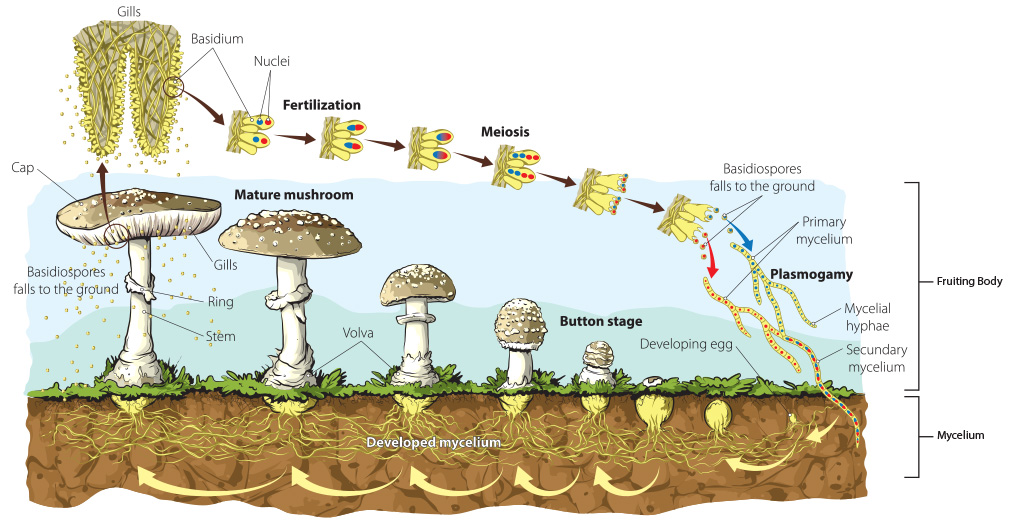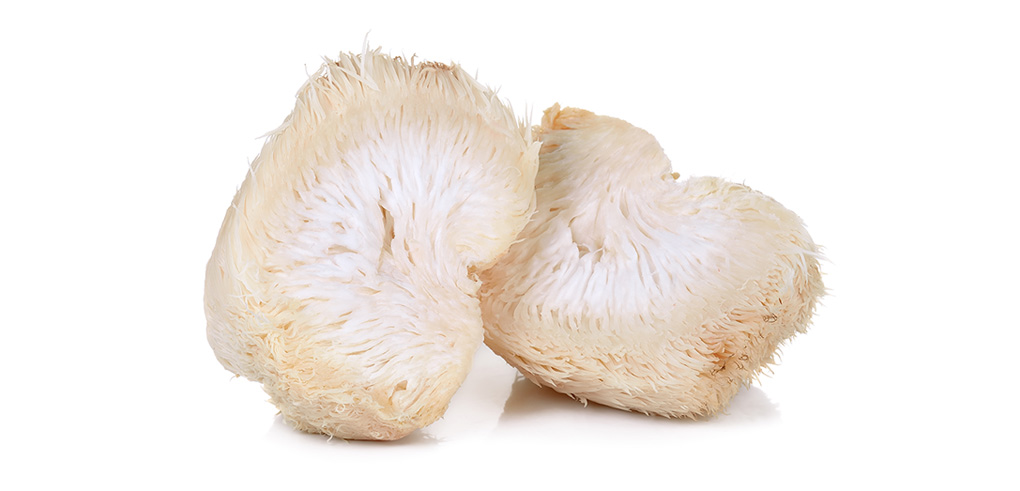The Benefits of Lion’s Mane Mushroom Extract
Lion's Mane is a culinary and medicinal mushroom native to Asia, Europe, and North America. It belongs to the tooth fungus group of mushrooms.
Lion's Mane Mushroom is used in food preparations such as soups, and it can also be made into teas or coffees. It is naturally found growing on trees in the late summer and can be identified by its white, fur-like appearance.
As a medicinal mushroom, Lion's Mane has many potential benefits which we'll cover later on.
The Chinese have been cultivating medicinal mushrooms for the various unique properties they offer for thousands of years. So it may come as no surprise that most of the world's mushrooms are grown and extracted there.
It is known by many different names, but these are some of the most common ones:
- Hericium Erinaceus
- Yamabushitake
- Pom Pom Mushroom
- Bearded Tooth Fungus / Mushroom
- Bearded Hedgehog Mushroom
- Satyr's beard
The Structure of a Mushroom

Before we get into specifics, it's good to understand the basic structure of a mushroom, which is comprised of the fruiting body and mycelium. The life and reproduction cycle of a typical mushroom can be seen in the diagram above.
Mushroom Fruiting Body
The fruiting body of a mushroom is the part that grows above ground, and it is how you typically identify a mushroom. The fruiting body contains the spores for reproduction, but it is also the most nutrient-rich part of a mushroom. The fruiting bodies and chitin within their cell walls contain a host of various vitamins and minerals, including B and C vitamins, zinc, copper, selenium, and other important nutrients.
Whole fruiting bodies are what high-quality mushroom extracts are produced from.
Mycelium
The mycelium usually grows underground and can be considered the roots of the mushroom. The mycelium provides nutrients to the rest of the mushroom, feeding the whole mushroom by processing and breaking down dead matter.
Mycelium based "mushroom" powders are inferior to whole fruiting bodies extracts because of the substrates they are grown on, and how they are processed. We explain this in the next section.
Lion's Mane Mushroom Cultivation and Extraction Processes
It is important to note that the most commonly available Lion's Mane mushroom products don't undergo an extraction process. They are simply dried and powdered mushrooms, sold as 'mushroom powder' or 'organic mushroom powder' if the substrate is organic.
While this seems fine at face value, the problem is that the release of the active compounds requires an extraction process because our bodies aren't able to break-down the chitin in the cell walls. Hot water extraction is the most commonly used method of extracting fruiting bodies, providing a high-enough temperature to isolate the medicinal compounds.
If the powder isn't an extract, it is likely to provide very few of the researched benefits due to a lack of a concentration of the medicinal nutrients. The extraction process is costly and time-consuming, which is why dried mushroom powder is significantly cheaper and medicinally inferior. It doesn't contain any Beta-Glucans, which is what determines a high-quality extract.
The substrate used to cultivate Hericium Erinaceus matters just as much as the extraction process. These factors dictate the quality and effectiveness of the final product.
Lion's Mane Mushrooms can be grown on various substrates, for example:
- Grain (rice, oats, even wheat grain)
- Wood Chippings
- Wood/Bark
- Soil
- Liquid Fermentations
Further to this, mushrooms can also be extracted using various solvents, these are the most common methods of extraction:
- Hot Water Extraction
- Ethanol Extraction
- Dual-Extraction (most effective for higher concentrations)
Just like with the botanical extracts, the source and extraction process is what sets apart a high-quality, standardized extract from a cheap, non-extracted powder. The differences are vast both in cost and benefits.
Believe it or not, the best, standardized mushroom extracts are produced in China. The Chinese have been cultivating medicinal mushrooms for thousands of years. There is no place more economical to produce good quality mushroom extracts than China.
Understandably, you may be skeptical. However, if you do your research, you'll find that all Lion's Mane Mushrooms grown in the USA are mycelium grown on grain. This is often referred to as myceliated rice or mycelium biomass on the product label.
The problem with mycelium on grain or grain spawn is since it is all ground up together, the finished powder mostly contains the grain that the mycelium has been grown on. Even if there are fruiting bodies present, the grain still makes up the majority of the final powder product.
Why is mycelium on grain even a thing? Because it's cheap to produce and many people don't know any better. Regulatory bodies have now gone as far as to take the position that mycelium grown on grain is not considered a mushroom.
If you're using a mycelium on grain Lions Mane powder, then you are actually consuming mostly starch from the growing substrate. A real, pure mushroom extract will contain very little if any starch. It should have a rich smell of mushrooms and not be sweet in taste.
Good quality mushrooms are first grown on an organic substrate. Then, the whole fruiting bodies are carefully harvested, dried and put through an extraction process multiple times in order to get the maximum concentration of medicinal compounds out of the fruiting bodies. Ideally, a dual-extraction process involving hot-water and ethanol is used.
After each extraction, an analysis is performed on the powder extract in order to establish the levels of Beta-Glucans. Repeating the extraction, and using dual-extraction processes, can significantly increase the concentration of medicinal compounds.
This is known as standardizing an extract. The finished extract powder will have an analytically verified and guaranteed amount of Beta-Glucans, thereby providing a consistent and measurable product. This is why standardized extracts are used in clinical research, and what you should look for when shopping for Lion's Mane - or any other medicinal mushrooms or botanical extracts. In fact, most clinical trials and research is done using fruiting body extracts.
Lion's Mane Mushroom Benefits

There are many potential benefits of Lion's Mane extract.
Lion's Mane contains a wide range of varying polysaccharides. Since there doesn't appear to be a scientifically validated method of accurately quantifying the concentration of Erinacines and Hericenones in Lion's Mane, the potency of a Lion's Mane extract is determined by the Beta-Glucan content.
Erinacines and Hericenones are compounds found in Lion's Mane Mushrooms that are said to support neuroplasticity by optimizing Nerve Growth Factor (NGF). The ones found in Lion's Mane Mushrooms are among the most potent naturally occurring compounds for inducing NGF production in vitro.¹ ² ³
Lion's Mane Mushroom extract has shown to exhibit neuroprotection via NGF stimulation. NGF is responsible for dealing with the growth and repair of neurons.
Here is a summary of the purported benefits of Lion's Mane Mushroom extract:
- Improves Brain Function
- Promotes Nerve Regeneration
- Exhibits Antioxidant Properties
- Combats Depression and Anxiety ?
- Supports the Immune System
- Decreases Inflammation
- Improves Cardiovascular Health
- Improves Circulation
- May Protect the Gut
- May Help Correct Circadian Rhythms
- May Assist in Alzheimer’s and Parkinson’s
Choosing a Quality Lion's Mane Mushroom Extract
There is a myriad of Lion's Mane products on the market. Because of this, it is important to understand what to look for when shopping for Lion's Mane as there are some significant differences between what is available.
The primary factor to pay attention to with a standardized extract is that the Beta-Glucan content is provided. Mycelium products generally list the polysaccharide concentrations (usually 30%) instead of Beta-Glucans. The problem is that high amounts of polysaccharides don't necessarily mean it's a quality product.
Mycelium-based products are high in starch because the grain is ground up with the small amount of mycelium that grows on it. Grain is high in starch, which is a type of polysaccharide.
Identifying Starch Content in a Mushroom Extract
If you're not sure if your mushroom product is grown on grain, it's relatively easy to find out. Purchase some iodine solution and add a few drops to a solution of warm water and mushroom powder/extract.
You will notice that the iodine doesn't react with the solution, due to the absence of starch in our extract. In the presence of starch, iodine will turn the solution dark purple or black.
It's evident that a standardized Lion's Mane Mushroom Extract made from whole fruiting bodies is higher quality and indeed superior to mycelium grown on grain.
Where to Buy Lion's Mane Mushroom Extract
If you're looking for organic, whole fruiting body Lion's Mane extracts, we offer a Lion's Mane Mushroom Extract in our UK store that is organically grown and dual-extracted from whole fruiting bodies. It contains a minimum of 25% Beta-Glucans.
